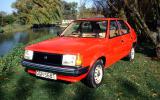Today we think of downsizing as a modern, original response to rising motoring costs, but our test of the £4950 Talbot Horizon suggests otherwise.
Some 35 years ago, this small saloon was seen as the ideal antidote to rising fuel costs (then averaging £1.28 per gallon, or 28 pence per litre) and, as such, took on the likes of the Austin Vanden Plas 1100 and Lancia Delta.
The key to persuading buyers of large saloons to buy smaller was – as now – to give the customer big-car technology in a small package. So the 1442cc Alpine engine was modified with a Weber twin-choke carburettor and linked to an automatic gearbox.
The interior was also trimmed in velour (although the author noted, somewhat sniffily, “a walnut veneer dashboard was out of the question for a French car, even if they could do it properly”). But the real party pieces came in the form of cruise control and an electronic trip calculator.
The road test started well enough, with performance being rated as brisk despite the hindrance of the torque converter. A top speed of 97mph and a 0-60mph time of 14.1sec may not sound like much to get excited about today, but it eclipsed the figures of rivals such as the Triumph Dolomite 1850 HL, Renault 5 and Vauxhall Chevette GL 4-d.
Meanwhile, economy of 26.5mpg was considered acceptable for the capacity of the engine – and was bettered only by the Renault 5 and Chevette – although the 6.4 per cent milometer inaccuracy was deemed “unacceptable”.
Road noise was acceptable up to 60mph but deteriorated rapidly at 70mph, while road behaviour received moderate praise for being predictable. Perhaps more importantly, given its mission, the interior was described as plush and comfortable, although the shortage of rear cabin space was heavily criticised.
So far, so good. But then came the verdicts on the two pieces of trick technology. “We do not feel that these two items, either singly or together, make any useful difference to the appeal of the car,” thundered the conclusion, which may well resonate with technophobes to this day.
The electronic trip computer came in for particular criticism. Its digital display may well have been switchable between time of day, elapsed time of trip, distance, amount of fuel consumed, fuel consumption and average speed (in imperial or metric), but Autocar’s ever-diligent testers benchmarked it and found its measurements to be consistently off kilter. “It is an amusing toy, yes,” noted our man, “but regrettably not to be taken at all seriously.”








Join the debate
Add your comment
Ahem...
Not often you see "Vanden Plas 1100" and "Lancia Delta" in the same sentence!
The Horizon didn't really
This was the first car to have this engine!
The legacy lives on, the 309 was nearly a Talbot, the 306->308 lineage are the direct descendants.
(The 305 was something of an oddball number and is probably more in line to the 405 -> 508 lineage).
that price